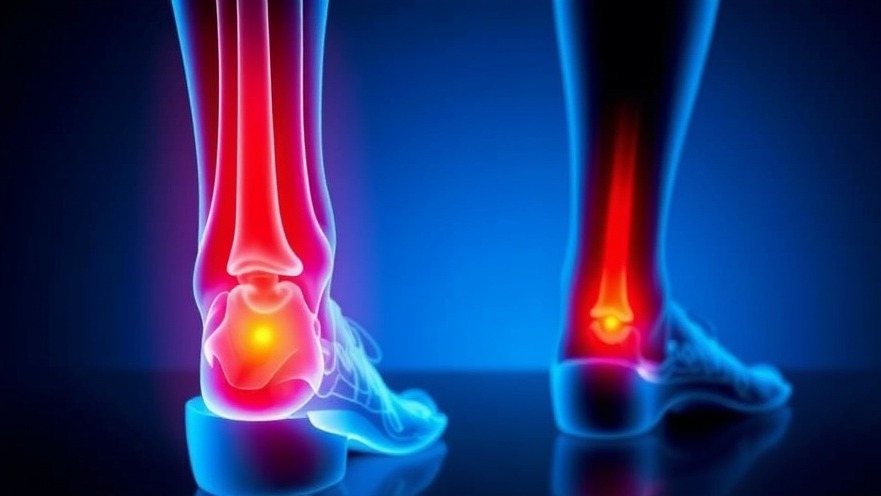
Understanding Heel Spur Pain: What You Need to Know
Heel spur pain can strike when you least expect it, often sidelining individuals who lead active lives. Whether you're an athlete, a parent chasing after children, or someone who enjoys strolls, the discomfort can be debilitating. Heel spurs, which are bony outgrowths on the heel bone, can irritate the surrounding tissue, commonly leading to a painful condition known as plantar fasciitis. This article will dive into revolutionary fixes for managing heel spur pain, offering insights tailored for patients seeking relief.
In 'Heel Spur Pain? Try This Revolutionary Fix!', the discussion dives into innovative ways to manage heel pain, exploring key insights that sparked deeper analysis on our end.
Key Symptoms and Their Impact on Daily Life
For those struggling with heel spur-induced pain, recognizing symptoms is crucial. Common signs include sharp pain under the heel or arch, especially during the first steps out of bed in the morning or after prolonged sitting. This pain can limit daily activities and influence overall well-being.
The psychological toll is also significant; persistent pain can lead to stress, anxiety, and decreased motivation to maintain a healthy lifestyle. By addressing heel spur symptoms with practical strategies, you can improve both physical and emotional health.
Revolutionary Fixes for Heel Pain
Combatting heel spur pain requires a multi-faceted approach. The good news is that an innovative blend of therapy and support can lead to significant improvements in overall well-being. Here are some practical solutions:
Foot Arch Stretches: Gentle stretching exercises can alleviate tension in the plantar fascia, enhancing flexibility and reducing inflammation. Incorporate stretches for arch pain into your daily routine to keep your feet limber.
Arch Support Devices: Products like the Ace Arch Support can offer immediate relief. They provide vital support and help distribute weight evenly across your feet, reducing strain on the heel.
Night Splints: Using a pf night splint, also known as a sock splint, can help keep your foot in a flexed position at night, facilitating healing of the plantar fascia and easing morning pain.
The Role of Proper Footwear in Healing
Choosing the proper footwear is pivotal for individuals with plantar fasciitis or heel spurs. Relying on the best walking shoes for plantar fasciitis 2025 can make a significant difference. These shoes typically provide arch support, cushioning, and stability, enabling pain-free movement. Consider models that accommodate foot arch variations to ensure optimal comfort, especially if you have a high arch.
When selecting dress shoes, also explore options like the best women's dress shoes for plantar fasciitis 2025. Not only do these shoes provide essential support, but they also allow you to maintain a fashionable appearance while taking care of your feet.
Recognizing and Managing Inflammation
Inflammation of the plantar fascia can exacerbate heel spur pain, making it crucial to implement a management strategy. Regular applications of ice, combined with plantar fascia stretching exercises, can reduce inflammation and relieve tension in the foot’s structure.
Additionally, consider taping techniques to provide extra support. Using plantar plate tear taping may offer benefits not only for heel spur pain but also for overall foot function.
Rehabilitation and Recovery
Understanding the timeline of recovery can also be beneficial. While plantar fascia tear recovery time varies from individual to individual, incorporating the right exercises can expedite the healing process. Simple activities such as calf stretches and towel pulls can strengthen the foot’s supporting muscles.
Moreover, integrating deep plantar arch exercises into your routine can further enhance recovery. By reinforcing the areas around the heel, you can manage pain and prevent future flare-ups.
Taking Action for Your Foot Health
In conclusion, heel spur pain can significantly impact your daily life, but there are effective strategies available to manage this discomfort. With proper stretches, supportive footwear, and innovative taping techniques, relief is within reach.
Don’t let heel pain dictate what you can or cannot do. Start taking proactive measures today. For personalized advice, consult with a healthcare professional to tailor a plan that suits your unique needs. Together, you can navigate your way to a pain-free lifestyle.
 Add Row
Add Row  Add
Add 




Write A Comment